Nationality English Parents James Burton (1761–1837) Role Architect | Name Decimus Burton Occupation Architect | |
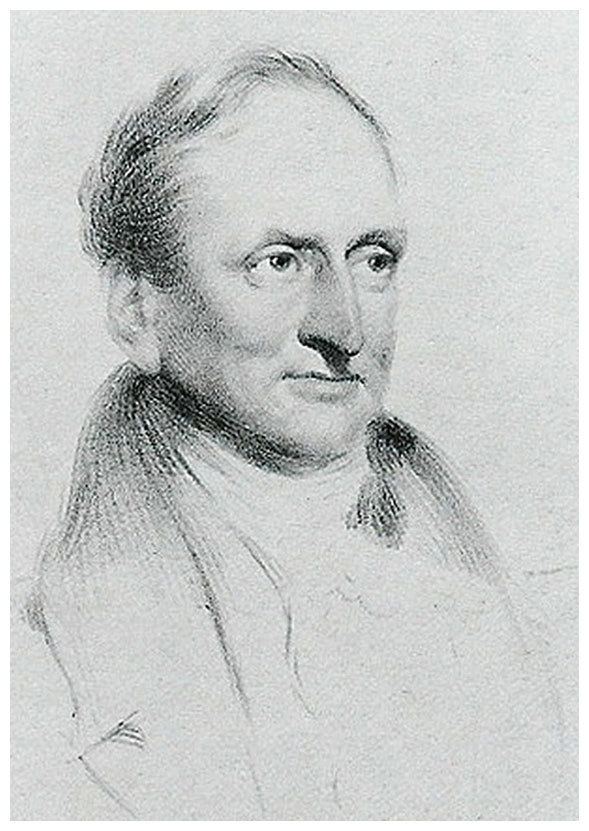 | ||
Structures Similar People Bertie Crewe, Arthur Wellesley - 1st Duke, William Pitt the Younger | ||
Closer look talk decimus burton
Decimus Burton (30 September 1800 – 14 December 1881) was one of the foremost English architects of the 19th century. He was a leading exponent of the Greek revival, Georgian and Regency styles. He was a founding Fellow and, later, Vice-President of the Royal Institute of British Architects, and architect to the Royal Botanic Society from 1840. He was an early member of the Athenaeum Club, London, whose Clubhouse he designed.
Contents
- Closer look talk decimus burton
- Victorian Holiday Treehouse for Iconic Designer Decimus Burton By Josie Kemper
- Family
- Education
- Style
- Relationship with John Nash
- Cliffords Inn
- Personal life
- Protges
- Legacy
- List of architectural works
- Buckinghamshire
- Derbyshire
- Dorset
- East Sussex
- St Leonards on Sea
- Regents Park
- Hyde Park
- Other London Works
- Hampshire
- Hertfordshire
- Kent
- Lancashire
- Norfolk
- North Yorkshire
- Nottinghamshire
- West Sussex
- Ireland
- References
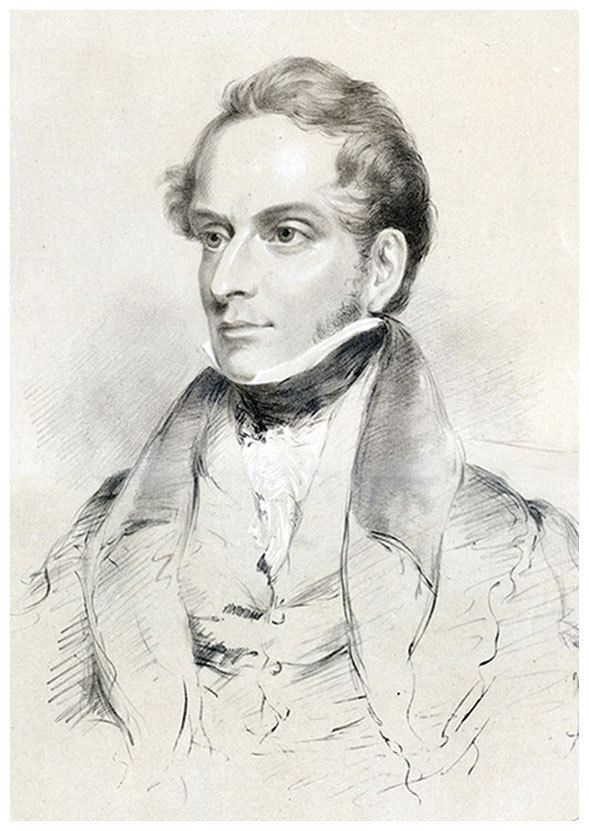
Decimus's works include Hyde Park, London, including Gate/Screen at Hyde Park Corner and the Wellington Arch, London Zoo, the Royal Botanic Gardens, Kew, the clubhouse of the Athenaeum Club, London, Regent's Park, London, including Cornwall Terrace, Chester Terrace, and the villas of the Inner Circle (including his own residence, The Holme), Green Park, London, Carlton House Terrace, and the layout and architecture of the seaside towns of Fleetwood and St Leonards-on-Sea and the spa town Tunbridge Wells. He also worked on Buckingham Palace, where he was responsible for the removal of Nash's Marble Arch facing the building to its present site and the subsequent enclosure of the forecourt.
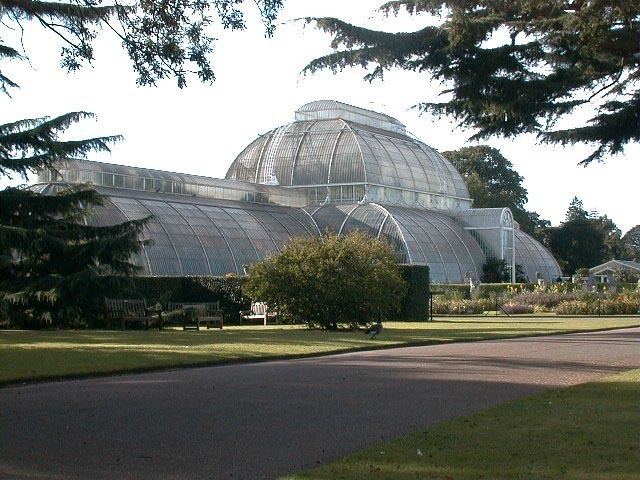
Decimus was the son of James Burton - the preeminent property developer of Georgian London, who built his son's projects around Regent's Park - by whom, Sir John Soane, and John Nash, to whom his father had granted financial assistance, he was taught. Decimus was a leading member of London society during the Regency era and Georgian era. His siblings included James Burton, the Egyptologist and Henry Burton, the physician who discovered the Burton line, and he was a cousin of the Canadian author Thomas Chandler Haliburton, Robert Grant Haliburton, and Lord Haliburton.
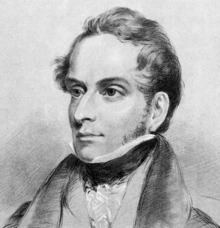
Decimus trained the architects Henry Marley Burton FRIBA, Henry Currey FRIBA, and Edward John May FRIBA.

Victorian Holiday Treehouse for Iconic Designer, Decimus Burton. By Josie Kemper
Family

Decimus was the 10th child of the property developer James Burton (formerly James Haliburton) and Elizabeth Westley (12 December 1761 – 14 January 1837), of Loughton, Essex, daughter of John and Mary Westley. On his father's side, his great-great grandparents were Rev. James Haliburton (1681–1756) and Margaret Eliott, daughter of Sir William Eliott, 2nd Baronet and aunt of George Augustus Eliott, 1st Baron Heathfield. Decimus was descended from John Haliburton (1573–1627), from whom Sir Walter Scott, 1st Baronet could trace his descent on the maternal side. He was a cousin of the American judge and author Thomas Chandler Haliburton and thence of the lawyer and anthropologist Robert Grant Haliburton and Arthur Lawrence Haliburton, 1st Baron Haliburton.
Education
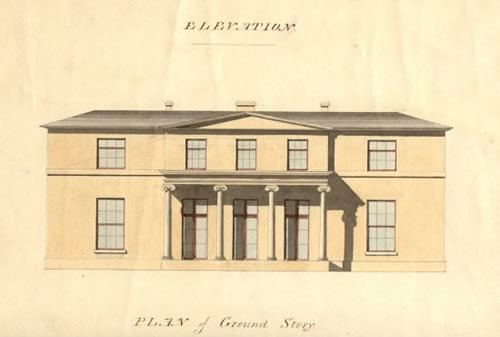
Decimus spent his formative years in his father’s mansion, Mabledon House, in Kent, which, coincidentally, after it had been sold by his father, he was commissioned to expand on several occasions.
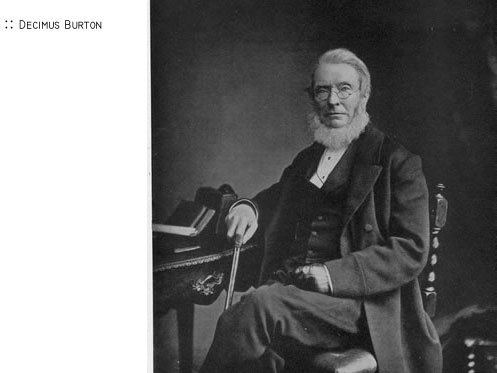
Decimus left Tonbridge School in 1816. Due to his father's social standing, he was able to enter the Royal Academy Schools directly, in 1817, without having been articled to an architect. Here he was taught by Sir John Soane, for whom his brother, James, had also worked. Decimus then trained with his father, during which time he receive drawing lessons from George Maddox.
Style
Decimus was exceptionally learned, as the diversity of his library, part of which was auctioned by his nieces, revealed. The sale catalogue listed 347 separate lots, some of which ran into many volumes. The collection indicates a range of interests beyond architectural theory and practice: it contained the Proceedings of the Camden Society complete in 135 volumes and transactions of many of the learned societies of which Burton was a member as well as a complete set of the Histoire Naturelle (70 vols.) of G. L. L. Buffon and Bernard Germain de Lacépède. The architectural texts comprised mostly standard works on classical architecture, such as the five volumes of Colen Campbell, Vitruvius Britannicus by John Woolfe and James Gandon, James Gibbs's Book of Architecture, and William Kent's The Designs of Inigo Jones. Alongside these, topographical views and surveys of cities and counties pepper the collection. There were also some foreign-language texts, including volumes by Charles Percier and Jean-Baptiste Rondelet, a complete set of Giovanni Battista Piranesi's works, and several dictionaries. Although Burton travelled to France and Spain, about which journey little is known, the absence of an educative grand tour early in his career meant that his books and casts were his sources for design. This goes some way towards explaining the formal academic character of his architecture.
Decimus was a leading exponent of the Greek revival style of architecture, although, uniquely, he was also significantly influenced by the styles of Ancient Rome. In his later career, he designed some buildings in the Gothic revival style, the ‘old English’ style, and the cottage orné style.
Decimus was one of the first architects to consider the implications of architecture on the creation of distinct urban environments in which they featured. Evidence given by Burton to two parliamentary select committees shows the diversity of his experience and, by virtue of his being asked, the esteem in which his opinion was held by contemporaries. Burton's evidence to the select committee of the House of Commons (1840), which discussed plans to develop Trafalgar Square, gave a more public platform to his views on urban planning. This is one of the first examples of public discussion about an urban space with acknowledged national and political significance.
Relationship with John Nash
Decimus came into contact with John Nash via his father, who was responsible for building many of Nash's London designs. Nash was appointed architectural 'overseer' for Decimus's Regent's Park projects: Cornwall Terrace, York Terrace, Chester Terrace and the villas of the Inner Circle, including The Holme. However, to the chagrin of Nash, Decimus disregarded his advice and developed the Terraces according his own style, to the extent that Nash sought the demolition and complete rebuilding of Chester Terrace, but in vain. Decimus also emerged as the dominant force in the design of Carlton House Terrace.
Clifford's Inn
From 1830 to 1834, Decimus studied at Clifford's Inn. Pevsner believes that Decimus designed the Gatehouse of the Inn.
Personal life
The inner circle of Decimus and his father and siblings included John Wilson Croker, John Nash, Sir Humphry Davy, and their cousin Thomas Chandler Haliburton, whom Decimus and his brother James Burton, the Egyptologist hosted on Thomas’s visits to London.
In 1832 Decimus Burton was elected a Fellow of the Royal Society. He was also a Fellow of the Royal Society of Arts, a Fellow of the Society of Antiquaries of London, a founding Fellow and later Vice-President of the Royal Institute of British Architects and architect to the Royal Botanic Society from 1840. Decimus was an early member of the Athenaeum Club, London, whose clubhouse he designed. His father was also an early member of the Club.
Protégées
Decimus trained as an architect his nephew Henry Marley Burton FRIBA (1821 - 1880), the son of his eldest brother, William Ford Burton, who succeeded to his architectural practice on his death. Henry Marley was a distinguished architect in his own right: in 1866, Henry Marley had commissioned by John George Dodson, 1st Baron Monk Bretton to design a mansion at Coneyborough; Decimus had designed Bineham in Chailey for Dodson's brother-in-law John George Blencowe. Decimus also taught the architects Henry Currey FRIBA and, together with his nephew, Henry Marley Burton, Edward John May FRIBA.
Legacy
Decimus retired in 1869 and Henry Marley Burton, his nephew, whom he had trained, succeeded to his architectural practice. Decimus died in December 1881. He is buried in Kensal Green Cemetery.
Decimus never married and died without issue. On his death, his property, including his extensive library and all of his architectural draughts and notes and draughts, passed to surviving members of his family. Despite the fact that he had left his library to the Royal Institute of British Architects, of which he had served as President, most of it was instead received by his two spinster nieces, Helen and Emily Jane Wood, who subsequently sold it, and the remainder was received by other members of the family. As a result of this, according to Dana Arnold, there is a gross imbalance between the ‘scale and significance’ of Decimus’s work and the amount of documentary evidence of it that is in the public domain, which has, together with the fragmentary nature of the written sources of his work in the public domain, undeservedly ‘tended to relegate Burton to the margins of architectural histories’. However, in his work around London, especially at Regent’s Park and Hyde Park, Decimus’s style achieves a resplendent memorial.
List of architectural works
(Listed by county in alphabetical order)
Buckinghamshire
Derbyshire
Dorset
East Sussex
St Leonards-on-Sea
In 1828 Burton's father James bought up an estate in East Sussex, on which he built the new town of St Leonard's-on-Sea as a pleasure resort for the aristocracy. Decimus designed the majority of the buildings.
Regent's Park
Hyde Park
Burton's work at Hyde Park, Green Park, and St James's Park begun in 1825, shows him to be one of the main executants of the vision of George IV and his ministers of London as a royal city rivalling its European counterparts. In collaboration with the king and his chief officials, Burton planned to create an urban space dedicated to the celebration of the House of Hanover, national pride, and the nation's heroes.
The project, which evolved in the 1820s, comprised creating two aligned entrances, the Wellington Arch at Constitution Hill into Green Park, London and the Hyde Park Gate/Screen at Hyde Park Corner. These two entrances would form part of a processional route for the monarch from Buckingham Palace to Hyde Park. The arch at Constitution Hill was left devoid of decorative sculpture as a result of the moratorium in 1828 on public building work, and was used instead, much to Burton's chagrin, as a plinth for an oversized and much ridiculed equestrian statue of the Duke of Wellington by Matthew Cotes Wyatt, which was later removed to Aldershot. In 1883 the arch at Constitution Hill was turned and resited to make way for increased traffic, and Burton's two aligned entrances were thus knocked off their axis.
Burton also laid out the paths and driveways and lodges of the Parks. He made new designs for the Stanhope, Grosvenor, and Cumberland gates. More ambitious plans for the parks that were not realized include the dramatic circular Bayswater Gate and Lodge and an entrance to Green Park from Piccadilly based on a Greek temple design.
Other London Works
Hampshire
Hertfordshire
Kent
Lancashire
Burton's work with his father on the East Sussex town of St Leonards-on-Sea (1827–1837) had impressed wealthy landowner and fellow Atheneaum Club member Sir Peter Hesketh Fleetwood who commissioned Burton to lay out his new port and seaside resort.
Norfolk
North Yorkshire
Nottinghamshire
West Sussex
Ireland
Martinstown House, Co Kildare (1833)
